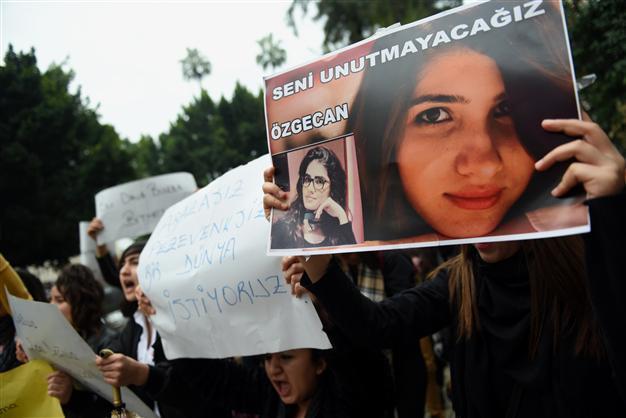Explained: How Özgecan’s murder united, divided Turkey
ISTANBUL

AA Photo
The brutal murder of 20-year-old university student Özgecan Aslan has united –and divided – Turkey. Here is a summary of the heinous crime and its repercussions in five questions.So few incidents in recent memory have managed to unite the people of Turkey, a country bitterly polarized over politics. Still, public reactions to the brutal murder of 20-year-old university student Özgecan Aslan have also included hints of what divides the country.
Here is a summary of the heinous crime and its repercussions in five questions:
1) What happened to Özgecan Aslan?
Özgecan Aslan, who was a psychology student at Çağ University in the southern Turkish province of Mersin, was killed on Feb. 11. Her burned body was found in a river bed two days after her family reported her missing. The driver of the minibus she boarded to return home confessed to the murder. He was arrested on Feb. 16 with two of his accomplices.
2) What are people in the street saying?
Thousands of people have been hitting the streets in an unprecedented demonstration of mourning and anger since the funeral on Feb. 14. Although the imam requested women step back during the ceremony, hundreds of women attending the ceremony paid him no heed, carrying Aslan’s coffin before and after the prayer. Elsewhere in Turkey, several women slammed the male-dominated system for perpetuating the problem of women’s murders and domestic violence. At the same time, some conservative voices have blamed “Western lifestyles” for fueling instances of rape, angering many. "I am potentially dead," Hürriyet columnist Melis Alphan wrote Feb. 16.
3) What are politicians saying?
Turkish President Recep Tayyip Erdoğan’s two daughters paid a visit to the victim’s family to extend condolences on Feb. 14, before Turkish Prime Minister Ahmet Davutoğlu announced the launching of an extensive campaign against violence against women across the country. Kemal Kılıçdaroğlu, leader of the main opposition Republican People’s Party (CHP), wrote on Twitter: “There is no harassment, rape, violence in the nature of women! We will all together say ‘no’ to this mentality!” Family and Social Policies Minister Ayşenur İslam and Economy Minister Nihat Zeybekci mulled the reintroduction of the death penalty, while Gaziantep Mayor Fatma Şahin proposed castration for sexual crimes.
4) What do the numbers say?
Regardless of how Özgecan Aslan’s killers will be punished, Turkey faces a grim picture regarding measures and sanctions against those who attack and harass women. The number of women murdered in a year in Turkey shot up 1,400 percent between 2002 and 2009, from 66 to 953, according to official data. After a brief period of decrease in the numbers, some 129 women were killed in the first half of 2014, up from 88 in the same period a year earlier, according to Aylin Nazlıaka, a CHP deputy. Some 133 women were killed in 2014 in acts of domestic violence, a 33 percent rise compared to the previous year, according to data recently submitted to parliament by the police, the gendarmerie and the Justice Ministry. A much-hyped panic button system intended to protect women against violence has been a failure, the government acknowledged in October 2014.
5) Is there any hope on the horizon?
Many Turks, who directly share their opinion through social media or by speaking to television and newspapers, say the political response is too little, too late. Others suggest it is more of a social problem in which the government has not much power to solve singlehandedly.
Meanwhile, reactions have precipitated an avalanche. Hundreds of women, including celebrities, have related horrific stories of sexual assault and harassment under the hashtag #sendeanlat (you tell your story too). The #Özgecaniçinsiyahgiy (Wear Black For Özgecan) hashtag was shared by thousands of social media users on Feb. 15 and 16, with people posting their photos wearing black to raise awareness about the increasing number of murders in which women are victimized.
The size of the campaigns, both on the street and on social media, might be hinting that public pressure on politicians to protect women’s lives and freedoms is likely to increase as the June 7 general elections approach.
















